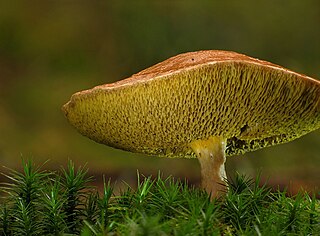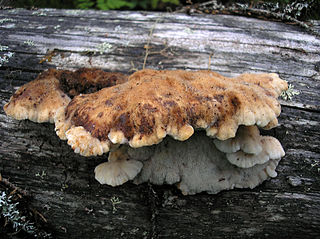
Polypores are a group of fungi that form large fruiting bodies with pores or tubes on the underside. They are a morphological group of basidiomycetes-like gilled mushrooms and hydnoid fungi, and not all polypores are closely related to each other. Polypores are also called bracket fungi or shelf fungi, and they characteristically produce woody, shelf- or bracket-shaped or occasionally circular fruiting bodies that are called conks.

Boletus edulis is a basidiomycete fungus, and the type species of the genus Boletus. Widely distributed in the Northern Hemisphere across Europe, Asia, and North America, it does not occur naturally in the Southern Hemisphere, although it has been introduced to southern Africa, Australia, New Zealand, and Brazil. Several closely related European mushrooms formerly thought to be varieties or forms of B. edulis have been shown using molecular phylogenetic analysis to be distinct species, and others previously classed as separate species are conspecific with this species. The western North American species commonly known as the California king bolete is a large, darker-coloured variant first formally identified in 2007.

Caloboletus calopus, commonly known as the bitter beech bolete or scarlet-stemmed bolete, is a fungus of the bolete family, found in Asia, Northern Europe and North America. Appearing in coniferous and deciduous woodland in summer and autumn, the stout fruit bodies are attractively coloured, with a beige to olive cap up to 15 cm (6 in) across, yellow pores, and a reddish stipe up to 15 cm (6 in) long and 5 cm (2 in) wide. The pale yellow flesh stains blue when broken or bruised.

Suillus bovinus, also known as the Jersey cow mushroom or bovine bolete, is a pored mushroom of the genus Suillus in the family Suillaceae. A common fungus native to Europe and Asia, it has been introduced to North America and Australia. It was initially described as Boletus bovinus by Carl Linnaeus in 1753, and given its current binomial name by Henri François Anne de Roussel in 1806. It is an edible mushroom, though not highly regarded.

Oxyporus is a genus of polypore fungi in the family Schizoporaceae. An individual family Oxyporaceae was described for the genus. A number of species in this genus are plant pathogens, causing a white rot. The genus is widely distributed.

Suillellus luridus, commonly known as the lurid bolete, is a fungus of the family Boletaceae, found in calcareous broadleaved woodlands in Europe. Fruit bodies appear in summer and autumn and may be locally abundant. It is a firm bolete with an olive-brown cap up to 20 cm (8 in) in diameter, with small orange or red pores on the underside. The stout ochre stem reaches 8–14 cm (3–6 in) high and 1–3 cm (0.4–1.2 in) wide, and is patterned with a red network. Like several other red-pored boletes, it stains blue when bruised or cut.

Haploporus is a genus of poroid fungi in the family Polyporaceae.

Antrodiella is a genus of fungi in the family Steccherinaceae of the order Polyporales.

Dichomitus is a genus of poroid crust fungi in the family Polyporaceae. It was circumscribed by English mycologist Derek Reid in 1965.
Grammothelopsis is a fungal genus in the family Polyporaceae. It was circumscribed in 1982 by Swiss mycologist Walter Jülich, with Grammothelopsis macrospora as the type species.
Megasporoporia is a genus of four species of crust fungi in the family Polyporaceae. The genus is characterized by its large spores, and dextrinoid skeletal hyphae.

Skeletocutis is a genus of about 40 species of poroid fungi in the family Polyporaceae. The genus has a cosmopolitan distribution, although most species are found in the Northern Hemisphere. It causes a white rot in a diverse array of woody substrates, and the fruit bodies grow as a crust on the surface of the decaying wood. Sometimes the edges of the crust are turned outward to form rudimentary bracket-like caps.

Imleria badia, commonly known as the bay bolete, is an edible, pored mushroom found in Eurasia and North America, where it grows in coniferous or mixed woods on the ground or on decaying tree stumps, sometimes in prolific numbers. Both the common and scientific names refer to the bay- or chestnut-coloured cap, which is almost spherical in young specimens before broadening and flattening out to a diameter up to 15 cm (6 in). On the cap underside are small yellowish pores that turn dull blue-grey when bruised. The smooth, cylindrical stipe, measuring 4–9 cm long by 1–2 cm thick, is coloured like the cap, but paler. Some varieties have been described from eastern North America, differing from the main type in both macroscopic and microscopic morphology.
Skeletocutis borealis is a rare species of poroid fungus in the family Polyporaceae. Found in northern Europe, it was described as new to science in 1998 by Finnish mycologist Tuomo Niemelä.
Skeletocutis brevispora is a species of poroid crust fungus in the family Polyporaceae. It was described as new to science in 1998 by Finnish mycologist Tuomo Niemelä.

Nigroporus vinosus is a species of poroid fungus in the family Steccherinaceae, and the type species of the genus Nigroporus. Its fruit bodies have brownish caps with tinges of purple or red. The cap underside has a pore surface the same colour as the cap, and minute pores. Nigroporus vinosus has a pantropical distribution. It has been recorded from Africa, North America, Central America, South America, Asia, and Oceania. It is a wood-decay fungus that causes a white rot.
Skeletocutis subvulgaris is a species of poroid, white rot fungus in the family Polyporaceae. Found in China, it was described as a new species in 1998 by mycologist Yu-Chen Dai. It was named for its resemblance to Skeletocutis vulgaris. The type collection was made in Hongqi District, Jilin Province, where it was found growing on the rotting wood of Korean pine.
Neodatronia is a genus of two species of poroid crust fungi in the family Polyporaceae. It was circumscribed in 2014 by Chinese mycologists Bao-Kai Cui, Hai-Jiao Li, and Yu-Cheng Dai as a segregate genus from Datronia. Neodatronia fungi differ microscopically from Datronia by having moderately to frequently branched skeleto-binding hyphae in the context, and by their somewhat smaller spores.
Leifiporia is a genus of two species of poroid white rot crust fungi in the family Polyporaceae. The genus was circumscribed by Chinese mycologists in 2016 to accommodate the type species Leifiporia rhizomorpha.

Amylocystis lapponica is a species of bracket fungus in the family Fomitopsidaceae, and the type species of genus Amylocystis. It produces medium-sized, annual fruit bodies that are soft, and have a strong, distinct smell. The fungus is a saprophyte that feeds on coniferous wood of logs lying on the ground, and causes brown rot. It is a rather rare species that only occurs in old-growth forest.













